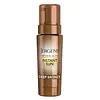What's inside
What's inside
 Key Ingredients
Key Ingredients

No key ingredients
 Benefits
Benefits

 Concerns
Concerns

 Ingredients Side-by-side
Ingredients Side-by-side

Water
Skin ConditioningGlycerin
HumectantDihydroxyacetone
Skin ConditioningAlcohol Denat.
AntimicrobialDecyl Glucoside
CleansingCeteareth-25
CleansingMethylparaben
PreservativeParfum
MaskingHydroxyethyl Acrylate/Sodium Acryloyldimethyl Taurate Copolymer
Emulsion StabilisingCitric Acid
BufferingSorbitan Isostearate
EmulsifyingPolysorbate 60
EmulsifyingBenzyl Alcohol
PerfumingErythrulose
TanningCitrus Aurantium Dulcis Peel Oil
MaskingCI 60725
Cosmetic ColorantSolvent Yellow 33
CI 14700
Cosmetic ColorantWater, Glycerin, Dihydroxyacetone, Alcohol Denat., Decyl Glucoside, Ceteareth-25, Methylparaben, Parfum, Hydroxyethyl Acrylate/Sodium Acryloyldimethyl Taurate Copolymer, Citric Acid, Sorbitan Isostearate, Polysorbate 60, Benzyl Alcohol, Erythrulose, Citrus Aurantium Dulcis Peel Oil, CI 60725, Solvent Yellow 33, CI 14700
Water
Skin ConditioningAloe Barbadensis Leaf Juice
Skin ConditioningIsopropyl Palmitate
EmollientBis-PEG-18 Methyl Ether Dimethyl Silane
EmollientCocoglycerides
EmollientDihydroxyacetone
Skin ConditioningButyrospermum Parkii Butter
Skin ConditioningGlyceryl Stearate
EmollientPolyacrylamide
Phenoxyethanol
PreservativeMethylparaben
PreservativeC13-14 Isoparaffin
EmollientTocopheryl Acetate
AntioxidantErythrulose
TanningParfum
MaskingPropylparaben
PreservativeLaureth-7
EmulsifyingCetyl Phosphate
EmulsifyingButylparaben
MaskingEthylparaben
PreservativeTriethanolamine
BufferingWater, Aloe Barbadensis Leaf Juice, Isopropyl Palmitate, Bis-PEG-18 Methyl Ether Dimethyl Silane, Cocoglycerides, Dihydroxyacetone, Butyrospermum Parkii Butter, Glyceryl Stearate, Polyacrylamide, Phenoxyethanol, Methylparaben, C13-14 Isoparaffin, Tocopheryl Acetate, Erythrulose, Parfum, Propylparaben, Laureth-7, Cetyl Phosphate, Butylparaben, Ethylparaben, Triethanolamine
Ingredients Explained
These ingredients are found in both products.
Ingredients higher up in an ingredient list are typically present in a larger amount.
Dihydroxyacetone, or DHA, is a simple sugar. It is frequently used in self-tanning products.
DHA binds to the amino acids in your dead skin cells to create a brown/orange color. Darkening begins to kick in a few hours after application and will continue to develop for up to 3 days. This ingredient can be drying.
Both the US and the EU have approved DHA in self-tanning products. In the EU, DHA is allowed at a maximum concentration of 10%. Most tanning products usually contain amounts between 3-5%.
If you are pregnant or have underlying medical conditions, it is best to speak with a dermatologist about using self-tanning products.
Learn more about DihydroxyacetoneWe don't have a description for Erythrulose yet.
Methylparaben is a preservative and is a paraben. It is used to prevent the growth of fungus, mold, and other harmful bacteria. Parabens are chemicals used as preservatives in both cosmetics and food.
Methylparaben can be synthetically created. It can also be found naturally in some fruits, such as blueberries.
Oftentimes, Methylparaben is combined with other parabens to help increase the shelf life.
The safety of Methylparaben is currently being studied. While ongoing studies are looking into the safety of parabens, the results have been very mixed. Some studies have not found Methylparaben to be harmful.
Learn more about MethylparabenParfum is a catch-all term for an ingredient or more that is used to give a scent to products.
Also called "fragrance", this ingredient can be a blend of hundreds of chemicals or plant oils. This means every product with "fragrance" or "parfum" in the ingredients list is a different mixture.
For instance, Habanolide is a proprietary trade name for a specific aroma chemical. When used as a fragrance ingredient in cosmetics, most aroma chemicals fall under the broad labeling category of “FRAGRANCE” or “PARFUM” according to EU and US regulations.
The term 'parfum' or 'fragrance' is not regulated in many countries. In many cases, it is up to the brand to define this term.
For instance, many brands choose to label themselves as "fragrance-free" because they are not using synthetic fragrances. However, their products may still contain ingredients such as essential oils that are considered a fragrance by INCI standards.
One example is Calendula flower extract. Calendula is an essential oil that still imparts a scent or 'fragrance'.
Depending on the blend, the ingredients in the mixture can cause allergies and sensitivities on the skin. Some ingredients that are known EU allergens include linalool and citronellol.
Parfum can also be used to mask or cover an unpleasant scent.
The bottom line is: not all fragrances/parfum/ingredients are created equally. If you are worried about fragrances, we recommend taking a closer look at an ingredient. And of course, we always recommend speaking with a professional.
Learn more about ParfumWater. It's the most common cosmetic ingredient of all. You'll usually see it at the top of ingredient lists, meaning that it makes up the largest part of the product.
So why is it so popular? Water most often acts as a solvent - this means that it helps dissolve other ingredients into the formulation.
You'll also recognize water as that liquid we all need to stay alive. If you see this, drink a glass of water. Stay hydrated!
Learn more about Water